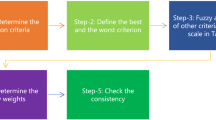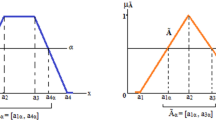Abstract
Life sciences industries, such as pharmaceutical and biochemical factories, have many limitations regarding raw materials management and procurement, including economic and regulatory decisions. Determining the criticality of these raw materials involves several risks in uncertain environments. However, with the raw materials criticality, the decision makers can help rank and prioritize actions for managing raw materials and their suppliers. Unfortunately, fuzzy system applications for raw materials criticality in life science industries were not found in the literature. Therefore, this article proposes a decision-making model using a two-stage fuzzy inference model to determine the criticality of the raw material in life science industries, using quality, regulatory, economic, and supply chain criteria. A practical application is carried out using data from a real pharmaceutical industry, and the main aspects of the new approach are discussed. Finally, an in-depth sensitivity analysis is performed by performing complete factorial experiments, demonstrating that the decision method does not have a trade-off among the criteria. The proposed fuzzy model can be adapted to various industrial sectors. In addition, the proposed decision model offers the possibility to work on raw materials criticality as a driver for continuous improvement initiatives in supply chain management.











Similar content being viewed by others
References
Abreu LR, Maciel IS, Alves JS, Braga LC, Pontes HL (2023) A decision tree model for the prediction of the stay time of ships in Brazilian ports. Eng Appl Artif Intell 117:105634
Albertin MR, Pontes HLJ, Frazzon EM, Frota ER (2016) Industrial performance assessment through the application of a benchmarking and monitoring system. In Dynamics in Logistics: Proceedings of the 4th International Conference LDIC, 2014 Bremen, Germany (pp. 643–653). Springer International Publishing
Azadeh A, Nasirian B, Haghighi SM (2019) An Intelligent Framework for Performance Optimisation of Integrated Management System and Resilience Engineering in Pharmaceutical Plants. Total Qual Manag Bus Excell 30(9–10):953–989
Azhar NA, Radzi NAM, Ahmad WSHMW (2021) Multi-Criteria Decision Making: A Systematic Review. Recent Advances in Electrical & Electronic Engineering (formerly Recent Patents on Electrical & Electronic Engineering) 14(8):779–801
Berezhnoy VI, Berezhnaya EV, Berezhnaya OV, Telnova NN, Ostapenko EA, Shatalova OI (2014) Methodology of application of the systematic and derivative analysis of the conditions of the local raw materials market development. Life Science Journal 11(8):600
Bertrand J, Will M, Jan CF (2002) Operations Management Research Methodologies Using Quantitative Modeling. Intern J Operat Prod Manag
Blumenthal D, Causino N, Campbell E, Louis KS (1996) Relationships Between Academic Institutions and Industry in the Life Sciences—an Industry Survey. N Engl J Med 334(6):368–374
Candan G, Yazgan HR (2016) A Novel Approach for Inventory Problem in the Pharmaceutical Supply Chain. DARU Journal of Pharmaceutical Sciences 24(1):1–16
Chin SY, Pontes HL, Porto ALV (2005, December) Retrieving process analysis in a parts distribution center: a case study of manual trolley fleet substitution. In Proceedings of the Winter Simulation Conference (pp. 7-pp). IEEE
Deming WE (2018) Out of the Crisis. MIT press
Denysenko MP, Chygyryk KO (2008) Risk Management Strategy for Pharmaceutical Industry Enterprises. ACTUAL PROBLEMS OF ECONOMICS, 81:57–62
Fadara TG, Wong KY (2022) A decision support system for sustainable textile product assessment. Text Res J 00405175221135167
Farajpour F, Taghavifard MT, Yousefli A, Taghva MR (2018) Information Sharing Assessment in Supply Chain: Hierarchical Fuzzy Rule-Based System. J Inf Knowl Manag 17(01):1850002
Ghadimi P, Toosi FG, Heavey C (2018) A Multi-Agent Systems Approach for Sustainable Supplier Selection and Order Allocation in a Partnership Supply Chain. Eur J Oper Res 269(1):286–301
Crouhy M, Galai D, Mark R (2004) Gerenciamento de Risco–Abordagem Conceitual e Prática. São Paulo: QualityMark 4
HOPE WT (2002) Introdução Ao Gerenciamento de Riscos. FUNENSEG, Rio de Janeiro
Hosseini-Motlagh SM, Jazinaninejad M, Nami N (2020) Recall Management in Pharmaceutical Industry Through Supply Chain Coordination. Ann Operat Res 1–39
Khan SA, Kusi-Sarpong S, Arhin FK, Kusi-Sarpong H (2018) Supplier Sustainability Performance Evaluation and Selection: A Framework and Methodology. J Clean Prod 205:964–979
Kraljic P (1983) Purchasing Must Become Supply Management. Harv Bus Rev 61(5):109–117
Kumar N, Jha A (2019) Application of Principles of Supply Chain Management to the Pharmaceutical Good Transportation Practices. Int J Pharm Healthc Mark
Liu Y, Eckert CM, Earl C (2020) A review of fuzzy AHP methods for decision-making with subjective judgements. Expert Syst Appl 161:113738
Lu K, Liao H, Zavadskas EK (2021) An Overview of Fuzzy Techniques in Supply Chain Management: Bibliometrics, Methodologies, Applications and Future Directions. Technol Econ Dev Econ 27(2):402–458
Mamdani EH, Assilian S (1975) An Experiment in Linguistic Synthesis with a Fuzzy Logic Controller. Int J Man Mach Stud 7(1):1–13
Montgomery DC (2017) Design and Analysis of Experiments. John wiley & sons
Moosavi J, Fathollahi-Fard AM, Dulebenets MA (2022) Supply chain disruption during the COVID-19 pandemic: Recognizing potential disruption management strategies. Intern J Dis Risk Reduct 102983
Nakov Z, Acevski S, Zareski R (2014) Implementation of Supply Chain Management (SCM) in Pharmaceutical Company, General Principles and Case Study. Macedonian Pharmaceutical Bulletin 60(2):75–82
Nascimento GAD, Barbosa JDS (2007) BPF Boas Práticas de Fabricação: Uma Revisão. Hig Aliment 24–30
Obert M, Harakal, M (2019) Fuzzy Inference System Application on High Level Security Model. In 2019 Commun Inform Technol (KIT) 1–9. IEEE
Osiro L, Lima-Junior FR, Carpinetti LCR (2014) A Fuzzy Logic Approach to Supplier Evaluation for Development. Int J Prod Econ 153:95–112
Rees H (2011) Supply Chain Management in the Drug Industry: Delivering Patient Value for Pharmaceuticals and Biologics. John Wiley & Sons
Runiewicz-Wardyn M (2020) Innovation Networks and the Evolution of the Life Sciences Industry. SOCIAL CAPITAL IN THE UNIVERSITY-BASED INNOVATION ECOSYSTEMS IN THE LEADING LIFE SCIENCES CLUSTERS 41
Sabbaghi MM et al (2020) A Supplier Selection Model Emphasizing the Project Risk Management in Drug Production in Pharmaceutical Industry. Tehnički Glasnik 14(2):111–120
Sharma A, Luthra G (2021) Importance of Risk Communication and Risk Analysis in Medical Device Industry. J Pharma Res Intern 32–41
SIAT J (2004) Practical Use of Supply Chain Management in the Pharmaceutical Industry from Concept to Implementation. Pharmazeutische Industrie 66(11A):1391–1397
Wang F, Wang J, Ren J, Li Z, Nie X, Tan RR, Jia X (2020) Continuous Improvement Strategies for Environmental Risk Mitigation in Chemical Plants. Resour Conserv Recycl 160:104885
Wang M, Jie F (2020) Managing Supply Chain Uncertainty and Risk in the Pharmaceutical Industry. Health Serv Manage Res 33(3):156–164
Zadeh LA (1965) Information and Control. Fuzzy Sets 8(3):338–353
Zanon LG, Arantes RFM, Calache LDDR, Carpinetti LCR (2020) A decision making model based on fuzzy inference to predict the impact of SCOR® indicators on customer perceived value. Int J Prod Econ 223:107520
Acknowledgements
This study was financed in part by the Coordena, cao de Aperfei, coamento de Pessoal de Nıvel Superior—Brasil (CAPES) – Finance Code 001 and the Conselho Nacional de Desenvolvimento Cient´ıfico e Tecnol ´ogico—Brasil—(CNPq)—through Grant nos. [306075/2017-2, 430137/2018-4, and 312585/2021-7].
Author information
Authors and Affiliations
Corresponding author
Ethics declarations
Conflict of Interest
The authors declare that they have no conflict of interest.
Additional information
Publisher's Note
Springer Nature remains neutral with regard to jurisdictional claims in published maps and institutional affiliations.
Rights and permissions
Springer Nature or its licensor (e.g. a society or other partner) holds exclusive rights to this article under a publishing agreement with the author(s) or other rightsholder(s); author self-archiving of the accepted manuscript version of this article is solely governed by the terms of such publishing agreement and applicable law.
About this article
Cite this article
Abreu, L.R., Nagano, M.S. A two-stage fuzzy inference model to determine raw materials criticality in life sciences industries. Oper Manag Res 16, 2048–2063 (2023). https://doi.org/10.1007/s12063-023-00392-x
Received:
Revised:
Accepted:
Published:
Issue Date:
DOI: https://doi.org/10.1007/s12063-023-00392-x




